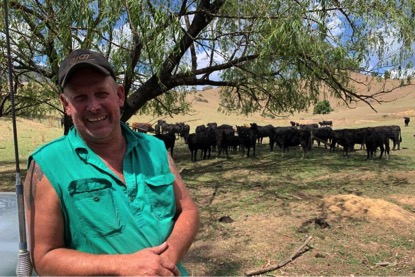6 June 2019
Landholders Michael and Beryl Ryan from Talbingo, NSW have been working with Riverina LLS and NSW National Parks and Wildlife Service for the past three years to aerial and ground bait wild dogs in a bid to stop them entering their property and attacking livestock.
Mrs Ryan said they had been losing about 80% of their Dorper lambs and 10% of their Angus calves to dog attacks. “Before the baiting and trapping, it just wasn’t worth running sheep here,” she said.
Mr Ryan said the stock losses had a significant financial impact on their business and took an emotional toll on the family. “It was very stressful, you would … go around there were dead lambs everywhere. Three years ago, it was very hard, the whole management system fell apart,” he said.
But life on the land is changing for the Ryans since the Riverina LLS and NSW National Parks and Wildlife Service (Parks) joined the battle. In a coordinated approach, LLS and Parks are taking care of the aerial baiting and the Ryans are ground baiting. Mr Ryan baits mainly between autumn and spring and believes baiting with 1080 poison buried in mounds to be most effective.
The Ryans now enjoy a 100% lambing rate, and the family is a lot happier because wild dog incursions have been significantly reduced. Mr Ryan explained: “They aren’t all gone, but the difference is the buffer zone, which we didn’t have before. The only buffer was our boundary fence. The dogs are in the forestry area 15km away but now with aerial baiting in the Park we have a buffer.”

The strategic and coordinated approach to wild dog control will now include exclusion fencing on their boundary with the Kosciusko National Park. The Ryans will erect the fence with materials provided by LLS and Parks.
But as Mr Ryan noted: “It’s just another tool, we still need to bait and trap.”

This need is understood only too well by the LLS and this autumn a broad scale aerial program targeting wild dogs, has dropped 22,800 baits across almost 600 kilometres on private and public land stretching from the ACT border to the Victorian border.
Toby O’Brien, Riverina LLS Senior Biosecurity Officer said: “We lifted bait numbers this year through increased private landholder participation, covering known and identified wild dog habitat. Year on year the program’s been growing and with the help of land managers we’ve refined our target areas,” he said.
Due to the fact that wild dogs know no borders, the baiting program covered both the Riverina and Murray Local Land Services regions. Toby noted: “It’s most effective when we bait in conjunction with Murray as we’re collectively covering seven Wild Dog Management Plan areas.”
Share